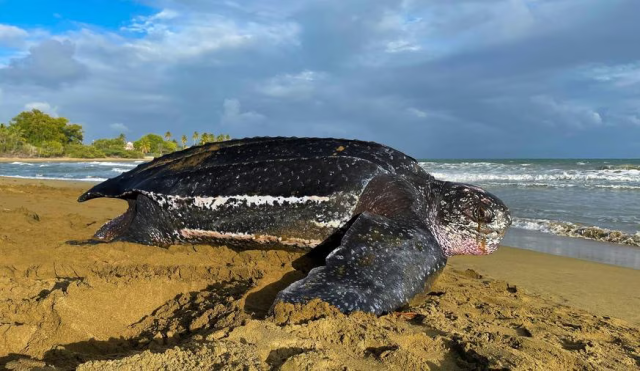Conservation specialists urge for the care of leatherback and other turtle species' habitats
Submitted on 24 May 2023 - 11:32am
This article is reproduced by CienciaPR with permission from the original source.
CienciaPR Contribution:
Original Source:

Editor's note: This story contains images of injured animals that may hurt some sensitivities.
_ _ _
The leatherback nesting period in Puerto Rico began at the end of March and may extend until July.
The leatherback nesting season in Puerto Rico began a little over a month ago. Given the reported cases that have resulted in the loss of this and other species of sea turtles, the organization Tortugueros del Sur urged the care of their habitats to ensure that hatchings can be successful.
"The hawksbill, the leatherback and the green turtle are three species that are clinging to a marine ecosystem that, if I eliminate them, we are going to have a serious ecological imbalance", said the director and founder of the organization, Guillermo Plaza Rodríguez, in an interview with El Nuevo Día.
He pointed out that last Saturday, on Tamarindo Beach, in Guayanilla, a case was reported in which a pack of dogs attacked a hawksbill turtle. According to Plaza Rodríguez, the animal suffered serious injuries to its front and hind legs that caused its death.
Plaza Rodríguez emphasized that the presence of stray animals on the beaches can contribute to the loss of turtles such as the leatherback turtle, which is at the peak of its nesting process.
"If you have any dogs, acquire any or are going to leave them, please be responsible. The abandonment of dogs on the beaches creates this type of situation", he said.
:format(jpeg)/cloudfront-us-east-1.images.arcpublishing.com/gfrmedia/3JZFEGM2OBFGDIOP57U2N7YDFE.jpg)
The hawksbill turtle was released from a large pack (more than 12), which attacked it causing serious injuries, leaving the bone exposed in both front and back legs (Guillermo Plaza Rodríguez).
In general, the leatherback nesting period in Puerto Rico begins at the end of March and can extend until July. However, although it is not common, it could be brought forward to February.
Plaza Rodríguez was incisive in that it is important to follow the recommendations of the experts for the preservation and care of these species, since the Caribbean is an important nesting center.
Specific tips to help the preservation of all turtle species, according to the organization Tortugueros del Sur:
- If you have pets, do not release them on beaches. In particular, if you have a dog and no longer wish to take care of it, take it to an animal center and do not leave it in the wild.
- Do not drive vehicles onto the beach, particularly in areas that are considered nature reserves by the Department of Natural Resources (DNER).
- Do not make bonfires on the beaches. In addition to affecting the species, it is illegal (according to law 430, section 7).
- Avoid causing light pollution. If you live near the beach, contact a species care and preservation group for guidance and offer other types of healthy lighting for the species.
- Keep the beaches clean, free of garbage, plastics and other materials that may be harmful to the species.
If at any time, you identify that a leatherback or other turtle species is at risk or you want to report a hatchling, you should follow the steps below:
- Do not approach the species or nest.
- Call a turtle conservation group.
- If you are unable to make contact with a group of turtle watchers, you should call the police visitor corps or the Emergency Management Office of the municipality where you are located.
- If at any time, you identify that a leatherback or any other turtle species is at risk or you want to report a hatching, you should call one of the turtle groups shown on this map. (Provided: Tortugueros del Sur)
It is important to track the species
On the other hand, Plaza Rodríguez said that they are currently using a global positioning system (GPS) to be able to track the species.
"The process began because organizations on the island of St. Kitts wanted to know the relationship between the tinglars that nest particularly in the Maunabo area and theirs. They wanted to see if the ones nesting here (Puerto Rico) were the same as the ones nesting there (St. Kitts)".
Likewise, with the location system, it is possible to know which areas the species prefer and where they go.
At the moment, thanks to the implementation of GPS, they have been able to verify that the leatherback is a more oceanic species and thus, they can plan the execution of the turtle groups with greater diligence, in order to preserve their spaces.
Regarding the areas that should be taken into greater consideration to protect, particularly the leatherback, the science professional concluded that: "They do not have a predilection for a beach, they can have a region, they can nest in Ponce, Juana Díaz and Guánica (regarding the southern region)".
:format(jpeg)/cloudfront-us-east-1.images.arcpublishing.com/gfrmedia/YSGI22S3VBATNMON2OUPXYIFGM.JPG)







